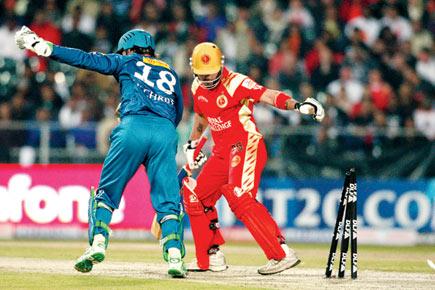In the mid-eighties Clive Lloyd and later Vivian Richards were captaining a world-beating West Indian team

In the mid-eighties Clive Lloyd and later Vivian Richards were captaining a world-beating West Indian team. Whenever his boys played India, I bunked school to come home and watch those five-day Test matches. They were an awesome display of tenacity, technique and skill. The cricketers in white on the green outfield were a lovely sight. There was something luxurious, indolent and English about the way Test cricket was played then.
ADVERTISEMENT

Whattay turn: Cricket’s entertain’mentisation is now complete, thanks to formats such as T20 and IPL. Pic/EPA
For anyone under 25 today, Test cricket today will seem like a boring old format for luddites. But in the one-channel, one radio station and one newspaper era when there were hardly any phones, forget mobile ones and no internet, Test cricket was the best entertainment after films. We liked the one-day matches or ODIs, but the true merit of a team was determined by its performance in the test cricket series.
Many of you probably remember how popular Bodyline (1984) an Australian TV series was in India in the late eighties.
Bodyline was the story of the critical battle for the Ashes during England’s tour of Australia in 1932-33. It showed English captain Douglas Jardine’s desperate and successful attempt to win back the Ashes by pushing his bowlers, especially Harold Larwood, to bowl at the line of the batsman’s body. This caused a huge number of injuries and one cracked skull in an age when protective gear was unknown. It also caused political and cricketing tension that the two countries have not seen since. It was a gentleman’s game, remember.
As luck would have it, almost 30 years later, cricket (not Test cricket) still happens to be the best form of entertainment. It makes up for 90 per cent of the audience and revenues that all sports get on from TV. India is one of the biggest generators of advertising, sponsorship and wealth in general around cricket (not to mention corruption!).
Over the years, I lost interest in the game and hardly watch it now, except for the odd match. But on a trip to London, I had to sit through several of the T20 matches being played in Bangladesh currently.
From a cricketing perspective they were terrible. The players look tired, they are encouraged to play rashly, push the rules, throw their bat about and generally do anything either to make a big target or chase it. The clothes are loud, the grounds look hot (everyone was sweating), there was almost constant background music, some drummers and masked men dancing around. However it was great entertainment for the Indian family I was staying with. They were glued to the set.
Some of the game’s greats might be rolling in their graves at the way T20 or IPL is played but the fact is that cricketers earn better, play more and do better stuff because of all the entertainment value these new formats offer.
If cricket is content for media such as TV, newspapers, magazines, online or radio, then it has gone down the same route that almost all content forms have. It has become shorter, crisper and tells its story quickly. Indian films are down from 3 hours and more to 2 to 2.5 hours and many even go to an hour and 30 minutes. Newspaper articles break up a big story in several smaller elements so that you and I can digest it quickly. The online portals are sensitive to the fact that we have become speed readers or human browsers. And books, well the literary ones are dying. The ones that work are crisper, quicker reads.
Cricket too has adapted to this world where audiences want to be entertained, told quickly what the point of the story is and want to see that story come to fulfillment. They don’t want to be hanging around for five days to know that their favourite team lost. In this process of shortening, cricket may have lost its grace and indolence but it has gained in money and size. It would be interesting to see how much more it could evolve. Maybe 5 over matches?
The writer is a media specialist and author. Follow her on twitter at https://twitter.com/vanitakohlik
 Subscribe today by clicking the link and stay updated with the latest news!" Click here!
Subscribe today by clicking the link and stay updated with the latest news!" Click here!






